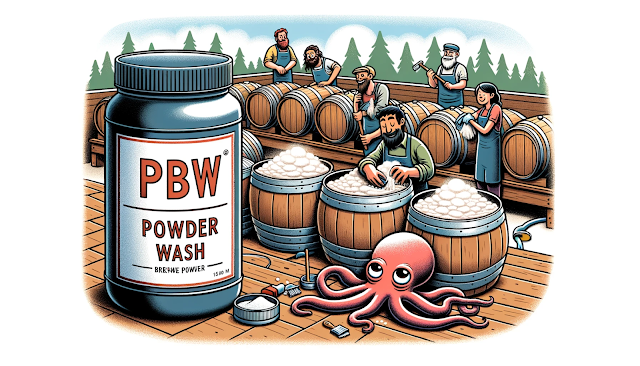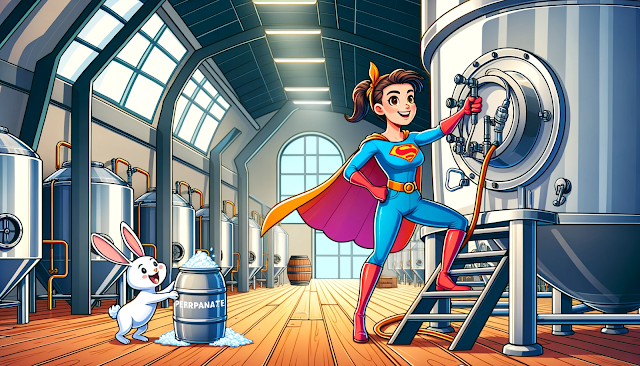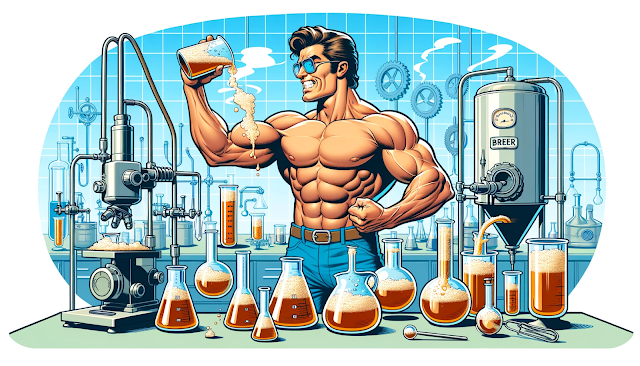For anyone deeply invested in the world of homebrewing, the quest for immaculate equipment is never-ending. We've all been there: staring at the bottom of a kettle with that stubborn, baked-on ring of protein, or trying to scrub the tenacious krausen residue from a fermenter.
It's in these moments that we realize a fundamental truth: we are cleaners first, and brewers second...
Enter PBW, or Powdered Brewery Wash, a cleaning product by Five Star that has rapidly become the gold standard for both commercial and home brewers alike.
Born from the need for a safer, effective alternative to caustic chemicals in professional breweries, PBW has established itself as an indispensable tool in every serious brewer's arsenal.
This guide will dive deep into what makes PBW so effective. We'll explore the science behind its powerful cleaning action, detail its most effective uses in the brewery, and clarify the critical distinction between cleaning and sanitizing to ensure your beer is not only delicious but safe from spoilage.
PBW at a Glance: Pros & Cons
Pros (What We Love)
- ✓ Unmatched Cleaning Power: Effortlessly dissolves the toughest baked-on organic soils like krausen and kettle trub.
- ✓ Safe on All Equipment: Non-corrosive formula is safe for stainless steel, plastic, glass, and soft metals.
- ✓ Reduces Manual Labor: The "soak and forget" method eliminates the need for hard scrubbing, saving time and effort.
- ✓ Effective in Hard Water: Contains chelating agents that prevent mineral deposits like beer stone from forming.
Cons (What to Consider)
- ✗ Higher Cost: Generally more expensive per use than DIY alternatives like OxiClean or sodium percarbonate.
- ✗ Requires Hot Water: Works most effectively at high temperatures (140°F+), which requires an energy input.
- ✗ Cleaner ONLY, Not a Sanitizer: You must still sanitize equipment on the cold side of your brewing process after cleaning.
- ✗ Thorough Rinse Needed: A complete and thorough rinse with hot water is required to remove all residue before use.
PBW's effectiveness isn't magic; it's a masterful blend of chemistry designed specifically to tackle organic brewing soils. Its power comes from a multi-pronged attack:
The Alkaline Powerhouse: Sodium Metasilicate
At its core, PBW is an alkaline (caustic) cleaner. Sodium Metasilicate provides the high pH needed to break down the two toughest culprits in the brewery: proteins and fats.
It works through a process called saponification, turning baked-on grime into water-soluble, soap-like substances that simply rinse away.
The Oxidizing Power: Sodium Percarbonate
This is the "active oxygen" component. When dissolved in hot water, Sodium Percarbonate breaks down into hydrogen peroxide and sodium carbonate. The hydrogen peroxide is a powerful oxidizing agent, literally lifting organic soils like yeast and hop residue off surfaces.
The sodium carbonate softens the water, allowing the cleaners to work more effectively.
The Unseen Hero: Chelating Agents
This is PBW's secret weapon. Hard water contains minerals like calcium and magnesium, which can bind with soils to form tough deposits like beer stone.
Chelating agents in PBW grab onto these minerals, taking them out of the equation.
This prevents beer stone from forming and allows the primary cleaning agents to attack the organic grime without interference.
Brewer's Insight: Why OxiClean Isn't a True PBW Substitute
Many brewers attempt a DIY PBW using OxiClean (mostly sodium percarbonate) and a TSP substitute. While this provides some cleaning power, it lacks the crucial chelating agents.
In areas with hard water, this DIY mix is far less effective at preventing beer stone and fully removing grime compared to the professionally formulated PBW.
Knowing how PBW works is one thing; using it effectively is another. Here's how to get the most out of this powerful cleaner.
The PBW User Manual: Dosage, Temp, and Time
Using PBW is straightforward, but following these parameters is key to success:
- Dosage: For general cleaning, use 1 ounce of PBW per gallon of water. For heavy-duty tasks like caked-on kettle trub or long-neglected fermenters, increase this to 2 ounces per gallon.
- Temperature: PBW works best in hot water. The ideal temperature range is 140-160°F (60-71°C). This temperature is crucial for fully activating the sodium percarbonate.
- Contact Time: For most applications, a 30-minute soak is sufficient. For truly stubborn messes, an overnight soak works wonders. The beauty of PBW is that it does the work for you—no scrubbing required.
- Rinsing: After soaking, you must rinse all equipment thoroughly with hot water to remove any chemical residue.
Key Applications in the Brewhouse
- Kettles and Fermenters: An overnight soak with PBW will dissolve the toughest krausen rings and burnt-on trub, leaving your stainless steel or plastic looking brand new.
- Kegs and Draft Lines: Regularly cleaning your kegs and beer lines with a PBW solution is critical for preventing off-flavors and infections. Circulate the solution through your lines for 15-20 minutes.
- Bottles and Label Removal: Struggling with sticky beer bottle labels? A 30-minute soak in a hot PBW solution will cause most paper labels to slide right off, and the solution will dissolve any sediment inside.
- Small Parts: Don't forget to soak your smaller items! Ball lock connectors, clamps, gaskets, and racking canes can all be cleaned together in a bucket of PBW solution.
This is the most critical concept for any brewer to master, and it is non-negotiable. While PBW is an exceptional cleaner, it is NOT a sanitizer.
Understanding the Difference
- CLEANING: The process of removing all visible dirt, grime, and organic soil. This is what PBW does. You must clean a surface before you can effectively sanitize it.
- SANITIZING: The process of reducing invisible microorganisms (bacteria, wild yeast) to a safe level where they cannot spoil your beer. This is what products like Star San do.
Even after a thorough PBW cleaning, a surface that looks perfectly clean can still be covered in microscopic beer spoilers. Any piece of equipment that touches your beer after the boil (the "cold side") must be sanitized immediately before use. This includes fermenters, airlocks, siphons, kegs, bottles, and bottling wands.
Skipping the sanitizing step is a gamble that will eventually lead to an infected, undrinkable batch of beer.
PW has rightfully earned its place in breweries around the world. Its powerful, scientifically formulated cleaning action saves brewers time, effort, and the frustration of scrubbing. By dissolving tough organic soils and preventing mineral buildup, it provides the perfect clean slate required for brewing high-quality, consistent beer.
By integrating PBW into your cleaning routine and always following up with a no-rinse sanitizer on your cold-side equipment, you elevate your process and significantly improve your chances of brewing the perfect pint, every time.








.png)
